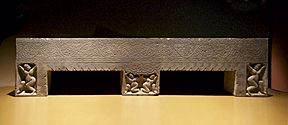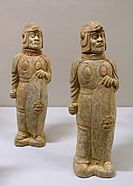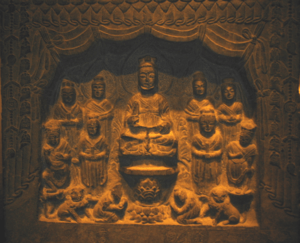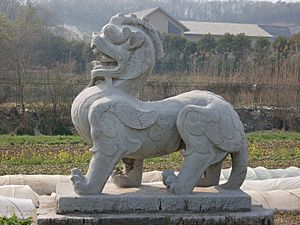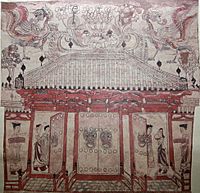Northern and Southern dynasties facts for kids
Quick facts for kids Northern and Southern dynasties |
|||||||||||||||||||||||
|---|---|---|---|---|---|---|---|---|---|---|---|---|---|---|---|---|---|---|---|---|---|---|---|
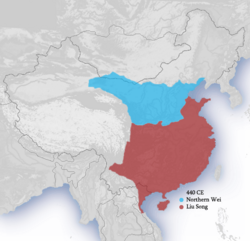
Approximate territories of the Northern Wei dynasty (blue) and Liu Song dynasty (red) in 440
|
|||||||||||||||||||||||
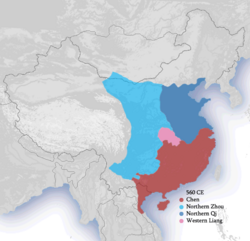
Approximate territories of the Northern Qi dynasty (dark blue), Northern Zhou dynasty (light blue), Chen dynasty (red), and Western Liang dynasty (pink) in 560
|
|||||||||||||||||||||||
| Chinese | 南北朝 | ||||||||||||||||||||||
|
|||||||||||||||||||||||
| Northern and Southern dynasties (386–589) | |||
|---|---|---|---|
| Northern dynasties | Southern dynasties | ||
| Northern Wei 386–535 | Liu Song 420–479 | ||
| Southern Qi 479–502 | |||
| Liang 502–557 | |||
| Western Wei 535–557 |
Eastern Wei 534–550 |
||
| Northern Zhou 557–581 |
Northern Qi 550–577 |
Chen 557–589 |
Western Liang 555–587 |
The Northern and Southern dynasties (Chinese: 南北朝; pinyin: Nán-Běi Cháo) was a time in history of China. It lasted from 420 to 589 AD. This period came after the Sixteen Kingdoms and the Eastern Jin dynasty. It was a time when China was divided into many smaller states.
Even though there was a lot of civil war and political chaos, it was also a time of great growth. Arts, culture, and technology became better. Mahayana Buddhism and Daoism also spread widely. Many Han people moved from the north to the lands south of the Yangtze River. The period ended when Emperor Wen of the Sui dynasty united all of China.
During this time, non-Han groups in the north and native people in the south became more like the Han Chinese. This process is called sinicization. Buddhism, which came to China in the 1st century, became very popular. Daoism also gained influence. Two important Daoist books were written then.
There were also important new inventions. The stirrup, invented earlier, helped create heavy cavalry as a main fighting style. Historians also note progress in medicine, astronomy, mathematics, and cartography. Famous thinkers included the mathematician Zu Chongzhi (429–500) and astronomer Tao Hongjing.
Contents
How the Dynasties Began
After the Eastern Han dynasty fell in 220 AD, China broke into the Three Kingdoms. Cao Wei was the strongest, followed by Eastern Wu and Shu Han. Later, the Sima family took control of Cao Wei. They conquered Shu Han.
In 266 AD, Sima Yan started the Western Jin dynasty. He conquered Eastern Wu in 280 AD, uniting China again.
The Western Jin dynasty became weak due to a civil war called the War of the Eight Princes (291–306 AD). Northern non-Han peoples, known as the Five Barbarians, rose up. These tribal groups had been moved to northern China before. When the princes forced them into the army, they rebelled. They sacked Luoyang in 311 AD and Chang'an in 316 AD.
A member of the imperial family, Sima Rui, fled south. He restarted the dynasty as the Eastern Jin dynasty. Their new capital was Jiankang (modern Nanjing).
In the north, the Five Barbarians created many short-lived states. This time is called the Sixteen Kingdoms. Eventually, the Northern Wei dynasty conquered the other northern states in 439 AD. This united northern China.
The Eastern Jin and later southern dynasties were protected by their navy along the Yangtze River. But they had problems keeping a strong army. The system of making certain families serve in the military lowered their social status. This caused many soldiers to leave. To get more troops, Eastern Jin generals often captured native people in the south to force them into the army.
The Eastern Jin dynasty did not fall due to outside invasion. Instead, Liu Yu, a general, took the throne from Emperor Gong of Jin. He founded the Liu Song dynasty in 420 AD. This marked the official start of the Northern and Southern dynasties period.
Northern Dynasties
The Northern dynasties began in 439 AD. This was when the Northern Wei united northern China. They ended in 589 AD when the Sui dynasty conquered the Chen dynasty. This period had three main parts:
- Northern Wei (386–535)
- Eastern and Western Wei (534–557)
- Northern Qi (550–577) and Northern Zhou (557–581)
The Northern, Eastern, and Western Wei, along with the Northern Zhou, were founded by the Xianbei people. The Northern Qi was founded by a Han Chinese who was influenced by Xianbei culture.
In the north, local Han Chinese families built strong, fortified villages. These families created their own small territories. Poorer peasant families worked for them as tenants or servants. This chaos made Han families avoid government service. Northern families were more focused on military strength than the refined southern families. This difference lasted for centuries.
Northern Wei (386–535)
How Northern Wei Rose to Power
During the Sixteen Kingdoms period, the Tuoba family of the Xianbei ruled the state of Dai (Sixteen Kingdoms). After the Former Qin dynasty fell, Tuoba Gui brought his clan back to power. He renamed his state Wei (now known as Northern Wei). Its capital was Shengle, near modern Hohhot.
Under Emperors Daowu, Mingyuan, and Taiwu, the Northern Wei grew stronger. Tuoba Gui fought many battles against the Later Yan. He won after getting help from Zhang Gun. This allowed him to destroy the Later Yan army at the Battle of Canhe Slope. After this victory, Tuoba Gui conquered the Later Yan capital of Pingcheng. He then declared himself Emperor Daowu.
Emperor Daowu was cruel and was killed by his son Tuoba Shao. But Crown Prince Tuoba Si defeated Tuoba Shao and became Emperor Mingyuan. He conquered Henan province from Liu Song. However, he died soon after.
Emperor Mingyuan's son, Tuoba Tao, became Emperor Taiwu. Under his rule, Northern Wei became very powerful. They attacked Liu Song many times. After dealing with the Rouran threat in the north, he fought to unite northern China. When the Northern Liang fell in 439 AD, Emperor Taiwu united northern China. This ended the Sixteen Kingdoms period and began the Northern and Southern dynasties.
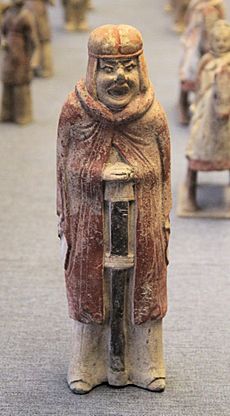
Even with great military strength, attacks from the Rouran in the north made Northern Wei focus less on southern expeditions. After uniting the north, Emperor Taiwu also conquered the powerful Shanshan kingdom. He also took control of other kingdoms in the Xiyu (Western Regions).
In 450 AD, Emperor Taiwu attacked Liu Song again. He reached Guabu (near modern Nanjing), threatening to cross the river to attack Jiankang, the Liu Song capital. Northern Wei forces were strong, but they suffered many losses. They plundered many homes before returning north.
At this time, Buddhist followers led by Gai Wu rebelled. After stopping this rebellion, Emperor Taiwu, advised by his Daoist prime minister Cui Hao, banned Buddhism. This was the first of the persecutions of Chinese Buddhism. Later in his life, Emperor Taiwu became very cruel. He was killed in 452 AD by the eunuch Zong Ai. His death caused chaos until Emperor Wencheng took the throne later that year.
In the first half of the Northern Wei dynasty, the Xianbei tribesmen who ruled northern China kept a strict social separation from their Han subjects. Han Chinese were used in the government to collect taxes. However, they were kept out of many higher positions of power. They were also a minority in the main centers of power.
Becoming More Chinese (Sinicization)
Major social and cultural changes in northern China happened under Emperor Xiaowen of Northern Wei (reigned 471–499). His father was Xianbei, but his mother was Han. Emperor Xiaowen was from the Tuoba Clan of the Xianbei tribe. But he embraced both his Xianbei and Han identity. He changed his own clan name to Yuan (meaning "elemental" or "origin").
In 493 AD, Emperor Xiaowen started a new program to make the Xianbei elites more like the Han Chinese. These changes included:
- Wearing Han clothing (Xianbei clothing was banned at court).
- Learning the Han language (for those under thirty).
- Changing Xianbei family names to one-character Han surnames.
- Encouraging high-ranking Xianbei and Han families to marry each other.
Emperor Xiaowen also moved the capital city from Pingcheng to Luoyang. Luoyang was an old imperial site and had been the capital during earlier dynasties. The new capital was rebuilt. About 150,000 Xianbei and other northern warriors moved there by 495 AD to serve in the capital. Within a few decades, Luoyang's population grew to about half a million. It became famous for having over a thousand Buddhist temples.
Starting in the 480s, the Northern Wei arranged for Han elites to marry daughters of the Xianbei Tuoba imperial family. More than half of the Tuoba Xianbei princesses married southern Han men. These men were from imperial families and nobles of the Southern dynasties who had moved north. For example, several daughters of Emperor Xiaowen of Northern Wei married Han elites.
In 523 AD, Prince Dongyang of the Northern Wei became governor of Dunhuang for fifteen years. As Buddhism became more accepted, Prince Dongyang and rich local families started a huge project. They carved and decorated Cave 285 of the Mogao Caves with beautiful statues and murals. This support for the arts continued for centuries at Dunhuang. It is now a major tourist attraction in China.
Northern Wei Splits Apart
In 523 AD, a revolt called the Rebellion of the Six Garrisons broke out. It was caused by a food shortage far north of Luoyang. After the rebels were stopped, 200,000 surrendered rebels were sent to Hebei. This proved to be a mistake. A former garrison officer started another rebellion in 526–527 AD.
The main reason for these wars was a growing split. The ruling nobles were adopting Han-style ways of life. But their nomadic tribal armies wanted to keep their old steppe lifestyle.
The Northern Wei court was betrayed by one of its own generals. He had the empress dowager and the young emperor thrown into the Yellow River. He then set up his own puppet ruler. As conflicts grew in the north, Gao Huan took control of the east and Luoyang in 534 AD. He held Emperor Xiaojing of Eastern Wei as a puppet ruler. His rival, Yuwen Tai, took control of the west and the old capital of Chang'an in 535 AD. The western government was controlled by nobles who had adopted Han culture. The eastern government was controlled by traditional steppe tribes.
Northern Qi (550–577) and Northern Zhou (557–581)
Eventually, Gao Huan's son Gao Yang forced the Eastern Wei emperor to give up his throne. Gao Yang then started the Northern Qi dynasty (551–577). Later, Yuwen Tai's son Yuwen Jue took power from Emperor Gong of Western Wei. He started the Northern Zhou dynasty (557–580).
The Northern Qi inherited most of the Northern Wei army's soldiers. Most military officers came from the eastern areas. These were often Han military families and steppe tribes who had settled there. These military families, both men and women, were skilled riders and archers.
Like the Western Wei, the Northern Zhou tried to bring back Xianbei warrior culture. They brought back Xianbei tunics, trousers, and boots. They changed Han surnames back to Xianbei names. They even gave Han officers Xianbei surnames. This policy aimed to turn many Han Chinese army recruits into "Xianbei." These new "Xianbei" would pay for their own equipment in exchange for not paying taxes. This policy greatly boosted the state's military strength.
The Northern Zhou dynasty defeated and conquered Northern Qi in 577 AD. This reunited the north. However, this success did not last long. The Northern Zhou was overthrown in 581 AD by Yang Jian. He became Emperor Wen of Sui.
With greater military power and strong belief that the Chen dynasty ruler Chen Shubao was a bad ruler, the Sui Dynasty conquered the south. After this conquest, all of China entered a new golden age. This was under the unified rule of the short-lived Sui dynasty and the later Tang dynasty (618–907).
The main leaders of the Northern dynasties were military families with mixed cultures and ethnicities. They later became the founding leaders of the Sui and Tang dynasties. They were flexible in dealing with steppe nomads, seeing them as possible allies.
Southern Dynasties
The Jin dynasty was followed by several short-lived dynasties in the south:
All these dynasties had their capital at Jiankang (except for a short time from 552 to 555). They are sometimes grouped with Eastern Wu and Eastern Jin as "the Six Dynasties". The rulers of these short dynasties were generals. They took power and held it for a few decades. But they could not pass power safely to their children. Emperor Wu of Liang (502–549) was the most famous ruler of his time. He supported the arts and Buddhism.
The Southern dynasties, except for the last Chen dynasty, were strongly controlled by the shijia, or great families. These families held all political power until the mid-6th century. This class was created by Cao Cao during the late Han dynasty. He tried to make a military class of professional soldiers. His policy led to the rise of the Sima family, who started the Jin dynasty. Later leaders also struggled to control these great families.
The Jin dynasty's move south made the central government even weaker. The great families who moved with the Emperor became the main power holders in the Eastern Jin. To get special rights, it became very important to prove one's family history. So, people started keeping detailed family records. The great families even made laws against marrying common families. Poor northern migrants became "guests" (dependents) of these great families. These families used their new followers to create private armies. When the Eastern Jin tried to draft these dependents into the army, the government was quickly overthrown.
However, after the Eastern Jin fell in 420 AD, the central government gained more power. The Liu Song, Qi, Liang, and Chen dynasties were ruled by military leaders from humble backgrounds. They slowly took away the military power, authority, and wealth of the powerful clans. The emperors placed regional armies around the country. They put their own relatives in charge. They also hired officers from poor backgrounds. They appointed low-ranking officials to watch the powerful elites in top government jobs.
The southern aristocracy declined as trade in the Indian Ocean grew in the mid-5th century. Government income shifted to trade. The old social classes disappeared by the Chen dynasty. Landowning nobles could not turn their farm produce into cash. The rise of trade and a money-based economy forced them to sell their lands to the growing merchant class. Influential merchants started holding political offices, replacing the old nobles.
Also, economic changes forced peasants to become mercenary soldiers. They could not pay taxes in cash. They wandered the country, selling their services to warring princes and robbing people. These troubles devastated the south. This made it easier for the Sui dynasty to conquer the south.
Under the weaker leadership of the Chen dynasty, the southern Chinese could not fight the strong army gathered in the north by Yang Jian. He declared himself Emperor Wen of Sui and invaded the south.
Native chiefs played an active role in adapting to Chinese rule. They were not just forced to obey. For example, the chief Lady Xian married the Liang court's governor Feng Bao. She helped spread the dynasties' power while keeping local culture. Lady Xian and Feng Bao helped Chen Baxian rise to power. They also helped stabilize the region between the Liang, Chen, and Sui dynasties. The court recognized her power by giving her official titles. There were many other local chiefs of mixed origins. They showed traits of both native and Chinese culture. These families acted as both chiefs to their people and officials for the court.
Liu Song (420–479)
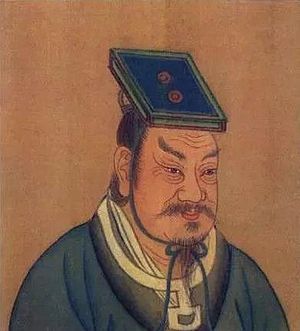
The founder of the Liu Song dynasty, Liu Yu, was a leader of the Army of the Northern Garrison. This army famously won the Battle of Fei River in 383 AD. In 404 AD, he helped stop Huan Xuan's rebellion. This made him very powerful in the Eastern Jin court.
To gain popularity and take the throne, he led military trips against the Sixteen Kingdoms. He captured Shandong, Henan, and briefly Guanzhong by 416 AD. He gave up Guanzhong to try to take the throne. He believed a prophecy said there would be one more emperor after Emperor An. So, he removed Emperor An and then his replacement, Emperor Gong of Jin, in 420 AD. This ended the Eastern Jin dynasty.
Even after becoming Emperor Wu, Liu Yu remained simple in his habits. However, he did not care for education and trusted bad people. He felt that the nobles had too much power. So, he often appointed lower-class people to government jobs. He gave military power to his imperial relatives. But he was afraid these relatives would try to take the throne. So, he often killed them.
After Emperor Wu died, his son Emperor Shao ruled briefly. He was judged unfit and killed by officials led by Xu Xianzhi. They replaced him with Emperor Wen, another son. Emperor Wen soon killed the officials who had supported him.
Emperor Wen's rule was a time of peace and stability. This was because he was careful with money and governed well. This period was called the Reign of Yuanjia.
In 430 AD, Emperor Wen started military campaigns against Northern Wei. These failed because he was not prepared enough. He also controlled his generals too much. This weakened the dynasty. He was jealous of Tan Daoji, a famous general. He got rid of Tan, which pleased Northern Wei. So, Liu Song could not take advantage when Northern Wei had problems.
Starting in 445 AD, Northern Wei attacked Liu Song. They took advantage of Liu Song's weakness. They invaded lands between the Yangtze and Huai rivers. They devastated six provinces. Emperor Wen regretted that Tan was no longer alive. From then on, Liu Song was weak.
Emperor Wen was killed by Crown Prince Shao and Second Prince Jun in 453 AD. He had planned to punish them for witchcraft. However, they were both defeated by Third Prince Jun. He became Emperor Xiaowu. This led to two rebellions by the imperial family. One rebellion saw him kill the people of Guangling. A folk song from that time describes it:
- Looking toward Jiankang city
- the little river flows against the current
- in front, one sees sons killing fathers
- and behind, one sees younger brothers killing older brothers
Emperor Xiaowu died naturally in 464 AD. His son, Emperor Qianfei, succeeded him. In a shocking move, he gave his sister 30 handsome young men as lovers. This was because she complained that it was unfair for men to have 10,000 concubines. His uncle Liu Yu, whom he called the "Prince of Pigs" because he was fat, eventually killed him. Liu Yu became Emperor Ming.
Emperor Ming began his rule by killing all the descendants of Emperor Xiaowu. His suspicious nature led to the loss of provinces north of the Huai River. These were only briefly regained by other Southern dynasties. Emperor Ming's young son became Emperor Houfei. The political situation was unstable. General Xiao Daocheng slowly gained power. He eventually removed Emperor Houfei. He replaced him with his brother, who became Emperor Shun. After defeating rival general Shen Youzhi, Xiao forced Emperor Shun to give up the throne. Xiao then crowned himself Emperor Gao of Southern Qi. This ended the Liu Song dynasty.
Southern Qi (479–502)
The Southern Qi and the following Liang dynasty were both members of the Xiao (蕭) family. They came from Lanling (in modern Cangshan County, Shandong). Because Emperor Gao had a low social standing, the nobles looked down on him. His way of governing was similar to the early Liu Song dynasty. It was very economical. He died in his fourth year, and his heir, who was only 13 years younger, became Emperor Wu of Southern Qi.
Emperor Wu made peace with the Northern Wei. He was content to protect his borders. This time of peace was known as Yongming Administration. He also used government secretaries to watch provincial governors and members of the imperial family.
The short reigns of Emperor Wu's grandsons, Xiao Zhaoye and Xiao Zhaowen, were controlled by Xiao Luan. Xiao Luan was Emperor Wu's first cousin. He killed them both and crowned himself as Emperor Ming of Southern Qi. Using the government secretaries, he killed all the sons of Emperors Gao and Wu.
Emperor Ming soon became very ill. He started following Daoism and changed all his clothes to red. He also ordered officials to find whitebait (a type of fish). He died in 498 AD. His son Xiao Baojuan succeeded him. Xiao Baojuan killed high officials and governors without reason, causing many revolts. The final revolt in 501 AD began after Xiao Baojuan killed his prime minister Xiao Yi. This led his brother Xiao Yan to rebel. Xiao Yan declared Xiao Baojuan's brother as Emperor He of Southern Qi.
Xiao Baojuan was killed by one of his generals during the siege of his capital at Jiankang. After a short rule by the puppet Emperor He, Xiao Yan overthrew the Southern Qi. He then established the Liang dynasty.
Liang (502–557)
Emperor Wu was careful with money. He worked hard at governing and cared for the common people. His early rule was known as Reign of Tianjian. The Liang dynasty's military strength grew stronger than Northern Wei's. Northern Wei was having internal problems due to its policy of sinicization. In 503 AD, Northern Wei invaded but was defeated at Zhongli (modern Bengbu).
Emperor Wu supported military expeditions to the north. But he did not fully use his victory in 516 AD at Shouyang because of heavy losses. Given the many killings within the imperial families of Liu Song and Southern Qi, Emperor Wu was very kind to his own relatives. He did not even investigate them when they committed crimes.
The Liang dynasty reached a cultural peak. Emperor Wu was very educated. He supported scholars and encouraged the education system. He loved poetry and gathered many talented writers at his court. He even held poetry competitions with prizes.
In his later years, flatterers surrounded him. Three times he tried to become a Buddhist monk. Each time, he was persuaded to return by large court donations to Buddhism. Also, Buddhists and Daoists did not have to pay taxes. Nearly half the population falsely claimed to be one, which badly hurt state finances. Imperial relatives and officials were also greedy and wasteful.
Emperor Wu was willing to accept generals who left Northern Wei. So when Northern Wei had major revolts in its northern towns, he sent his general Chen Qingzhi to support a pretender named Yuan Hao. Even though Chen only had 7,000 troops, he defeated many armies. He even captured Luoyang, the capital of Northern Wei. But Chen did not have enough supplies and was defeated by troops ten times his size.
After Northern Wei split into Eastern and Western Wei, Emperor Wu gave safety to a rebel Eastern Wei commander, Hou Jing. He sent Hou on northern expeditions against Eastern Wei. After some early successes, Liang forces were badly defeated. Rumors spread that Emperor Wu planned to give Hou to the enemy as a peace offering. Despite Emperor Wu's promises, Hou decided to rebel. He did so in the name of Xiao Dong, the grandson of a former crown prince. Hou surprised Emperor Liang by attacking the Liang capital at Jiankang. Liang forces failed to break the siege. Emperor Wu was forced to agree to a ceasefire. However, Hou broke the ceasefire and captured the palace. This led to the killing of many people nearby. Emperor Wu was starved to death. After short puppet reigns by Xiao Gang and Xiao Dong, Hou seized power and started the Han dynasty.
Even though Hou conquered Jiankang, he only controlled the nearby areas. The rest of the Liang dynasty lands were controlled by members of the imperial family. Their fighting among themselves weakened their efforts to defeat Hou. In the end, Xiao Yi, with help from his generals Wang Sengbian and Chen Baxian, defeated Hou. Xiao Yi crowned himself Emperor Yuan of Liang. His brother Xiao Ji in Sichuan was still a threat. Emperor Yuan asked Western Wei for help to defeat Xiao Ji. But after defeating Xiao Ji, Western Wei kept Sichuan.
Due to a diplomatic mistake, Emperor Yuan angered Yuwen Tai, the leading general of Western Wei. This led to Emperor Yuan being removed from power and dying. Western Wei set up a puppet state called Western Liang with its capital at Jiangling. Northern Qi also wanted the Liang throne. They sent an army under a cousin of Emperor Yuan. Chen Baxian and Wang Sengbian set up the last surviving son of Emperor Yuan, Xiao Fangzhi, as the Liang ruler. But he was not given the imperial title. After some defeats to Northern Qi, Wang Sengbian allowed their pretender, Xiao Yuanming, to become Emperor Min of Liang. However, Chen Baxian was unhappy with this. He surprised Wang, killed him, and removed Emperor Min from power. He put Xiao Fangzhi back as Emperor Jing of Liang. After a short rule, Chen removed Emperor Jing and took power himself as Emperor Wu of Chen in 557 AD.
Chen (557–589)
Emperor Wu of Chen came from the Wu region (near modern-day Shanghai). At that time, because of the Hou Jing rebellion, many clans were weakened. Many independent rulers appeared. Emperor Wu could not control all of them, so he used peaceful methods.
After Emperor Wu's sudden death, his nephew Chen Qian took power as Emperor Wen of Chen. After Liang fell, General Wang Lin had set up an independent kingdom. He was now causing trouble. Wang Lin allied with Northern Zhou and Northern Qi to conquer the Chen capital at Jiankang. Emperor Wen first defeated the combined forces of Northern Qi and Wang Lin. Then he stopped Northern Zhou forces from entering the South at Yueyang.
Also, Emperor Wen worked hard at good governance. The economic situation of the South greatly improved. This restored his kingdom's strength.
After Emperor Wen died, his son, the weak-willed Chen Bozong, took power as Emperor Fei of Chen. His uncle, Chen Xu, controlled the country during his short reign. Eventually, Chen Xu removed him and took power as Emperor Xuan of Chen.
At that time, Northern Zhou wanted to conquer Northern Qi. They asked the Chen dynasty for help. Emperor Xuan agreed because he wanted to get back the lost lands south of the Huai River. In 573 AD, he sent General Wu Mingche to help. In two years, he got back the lost lands. Northern Qi was in a bad situation with little military strength. Emperor Xuan could have defeated Northern Qi completely. But he only wanted to protect his lands south of the Huai River.
Instead, Northern Zhou took advantage of Northern Qi's weakness. After defeating Northern Qi in 577 AD, they sent troops to the lands south of the Huai River. They decisively defeated the Chen dynasty forces. The Chen dynasty was in great danger.
Luckily, Northern Zhou's Emperor Wu suddenly died. His general Yang Jian tried to take the throne. This stopped the northern troops from advancing south. The break was short. After Yang Jian defeated his rival General Yuchi Jiong, he took the throne from Emperor Jing of Northern Zhou. He established the Sui dynasty, crowning himself Emperor Wen of Sui. He then invaded the south to reunite China.
Emperor Xuan had just died. His incompetent son Chen Shubao took power. He was corrupt and wasteful. This caused chaos in the government. Many officials exploited the people, causing great suffering.
To defeat the Chen dynasty, Emperor Wen of Sui followed his general Gao Jiong's advice. He waited until the South was harvesting their crops. Then he burned all the farmland. This crippled the Chen dynasty's strength. In 588 AD, Emperor Wen of Sui sent his son Yang Guang (who would become Emperor Yang of Sui) to finally defeat the Chen dynasty. Chen Shubao relied on the Yangtze River as a natural barrier. He continued his festive activities as usual. The next year, Sui forces captured the Chen capital of Jiankang. Chen Shubao and his favorite concubine Zhang Lihua tried to hide in a well. But they were captured by Sui forces. This ended the Chen dynasty.
Diplomacy and Relations
The Liu Song dynasty tried to make an alliance with the Rouran, Goguryeo, Tuyuhun, and smaller local powers. Their goal was to defeat the Northern Wei. But this failed. After that, the North and South had to accept each other as equals. For example, they gave each other the highest positions for their envoys.
Historical records show that the language changed. Instead of calling each other "barbarians," they started calling themselves "Northern" and "Southern" parallels. They used their unique local customs to show their legitimacy and compete.
Population Changes
During the Northern and Southern dynasties, the first large-scale movement of Han people to southern China happened. This was south of the Yangtze River. This process of becoming more Chinese helped develop the region. Before, it had isolated communities separated by wild areas and other non-Han groups. During this period, the south went from being a frontier area to becoming a thriving, urbanized, and Chinese-influenced region. This continued in later centuries.
The Yangtze valley changed a lot during this time. It went from being a less developed area with less than 25% of China's population. It became a major cultural center with 40% of China's population. After China was reunited under the Tang dynasty, it became the core area of Chinese culture.
Culture and Arts
Language Differences
When the Jin court fled south, they continued to speak the refined common language from the Central Plains in the North. This language was seen as very important. However, many local southern Chinese did not want to adopt the speech of the newcomers.
During the Southern dynasties, a new elite way of speaking developed around the capital of Jiankang. This happened from the mid-4th century and spread widely by the 5th century. It had clear differences in pronunciation and phrasing from the Central Plains speech. Meanwhile, the court language in the North also changed. This was because Han Chinese officials learned Xianbei and Xianbei people learned Chinese. By the 6th century, southern elites thought the Luoyang accent sounded "crude and clumsy."
Philosophy and Thought
Confucianism's strong hold on Chinese culture and thought weakened during the Jin dynasty. This led to many different political ideas and philosophies during the Northern and Southern dynasties. This era produced many writers who suggested practical ways to govern. These included Cao Cao and Zhuge Liang in the Three Kingdoms Period, and others like Fan Zhen later on.
Much of the philosophy from this time was sad and discouraged. Many scholars and poets became hermits, living alone in the mountains away from society. Of these ideas, Neo-Daoism was the most important. Neo-Daoism was very popular during the Southern Dynasty. Emperor Wen of Liu Song even created a Neo-Daoist Academy. He promoted it along with Confucianism, literature, and history as the four main subjects to study.
A trend called "empty chat" became common. Educated men would meet and talk about philosophy all day. They ignored "normal" things like their jobs or families. This trend slowly faded during the Sui dynasty. It completely disappeared by the Tang dynasty.
Literature and Poetry
Literature was especially lively during the Southern Dynasty. It tended to be fancy and detailed. Northern Dynasty literature was rougher and more direct. Famous writers included Yu Xin and Wei Shou from the Northern Dynasty.
In poetry, fu poetry continued to be popular. But the five-syllable form, which became very famous during the Tang dynasty, slowly grew in popularity. In the Southern Dynasty, a type of essay called pian wen became popular. It used metered rhyme, fancy language, and references to old stories. Writings often talked about leaving everyday life and getting rid of worries.
Poets of the Northern and Southern dynasties focused on copying older classical poets. They made strict rules for rhyme patterns and meters in poems. However, scholars realized that old songs and poems, like those in the Shijing, often no longer rhymed. This was due to changes in how words sounded over centuries.
The introduction of Buddhism to China brought Sanskrit to Chinese scholars. The Brahmi script, with its organized sounds, came to China in the 5th century. Xie Lingyun studied it and created a (now lost) list of Chinese spellings for Sanskrit words. These were "arranged according to the 14 sounds."
The four tones of early Middle Chinese were first described by Shen Yue and Zhou Yong.
Other Arts and Learning
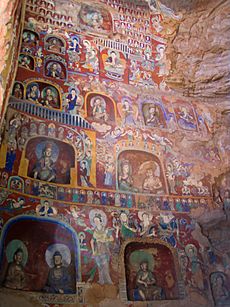
The southern dynasties of China had many cultural achievements. Buddhism and Daoism flourished. Two new sets of holy writings were created for the Supreme Purity sect and the Numinous Treasure Sect of Daoism. Southern Chinese were greatly influenced by Buddhist monks like Huiyuan. He used familiar Daoist terms to explain Buddhism to other Chinese. The Chinese also had contact with and were influenced by cultures from India and trading partners further south, like the kingdoms of Funan and Champa.
The Chinese arts of poetry, calligraphy, painting, and music reached new heights during this time. Cao Zhi, son of Cao Cao, is seen as one of the greatest poets of his day. His style and deep emotions in writing influenced later poets like Tao Qian (365–427). Even during his lifetime, the calligraphy of the "Sage of Calligraphy," Wang Xizhi (307–365), was highly valued. It was seen as a true form of personal expression, like other arts. Painting became very important with artists like Gu Kaizhi (344–406). He largely started the tradition of landscape art in classical Chinese painting.
Learning institutions in the south were also famous. This included the Zongmingguan (Imperial Nanjing University), where the famous Zu Chongzhi (mentioned earlier) studied. Zu Chongzhi created the new Daming Calendar in 465 AD. He calculated one year as 365.24281481 days. This is very close to today's known value of 365.24219878 days. He also calculated the number of overlaps between the sun and moon as 27.21223. Using this number, he correctly predicted 4 eclipses over 23 years (from 436 to 459).
Although multi-story buildings existed before, during this period the unique Chinese pagoda tower developed. Pagodas were used for storing Buddhist scriptures. They evolved from the stupa, which came from Buddhist traditions in ancient India.
Maps
See also
 In Spanish: Dinastías meridionales y septentrionales para niños
In Spanish: Dinastías meridionales y septentrionales para niños
- Military history of the Northern and Southern dynasties
- Timeline of the Northern and Southern dynasties
- Northern and southern China
- Chinese sovereign
- List of tributaries of Imperial China
- Buddhism in China
- Empress Dowager Hu (Northern Wei)
- Yan Zhitui
- Jinping Commandery





